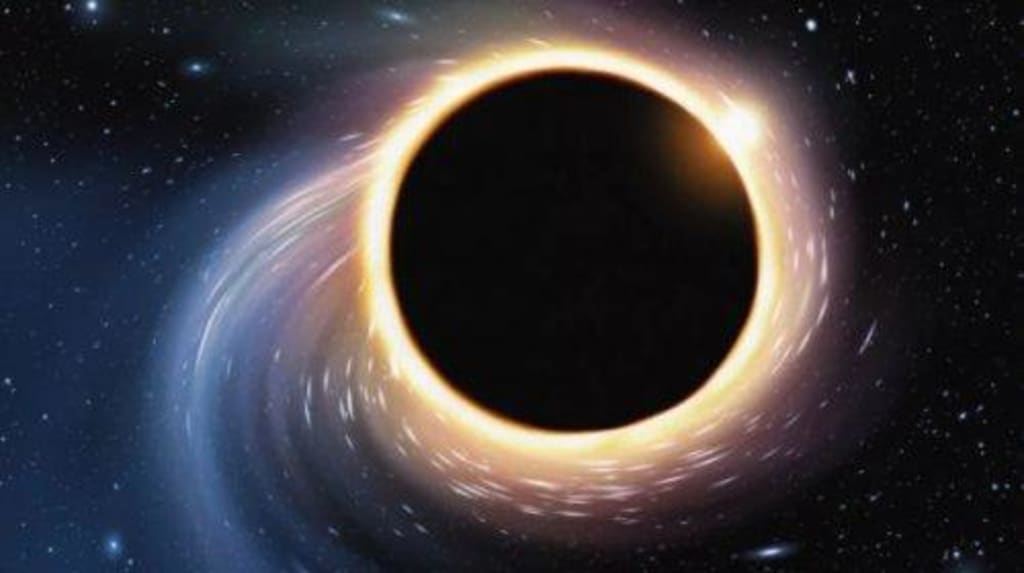
The concept of infinite density points comes from our perception of black holes that are stationary, non-spinning, and uncharged. Real black holes are much more interesting, especially when they are spinning
The singularity at the center of a black hole is the ultimate "no man's land": here, the matter is compressed to an infinitely small point, and all notions of time and space are completely shattered. The singularity does not exist, and something must replace it, but we are not sure what it is. Next, let's explore some strange possibilities.
Planck stars
Deep inside a black hole, the matter may not be compressed into an infinitely small point. Instead, the matter may have one of the smallest possible configurations, i.e., the smallest possible volume.
This is called a "Planck star," a type of object envisioned in quantum gravity theory. A Planck star is created when the energy density of a collapsing star reaches the Planck energy density. The theory of lap-quantum gravity is itself highly hypothetical and, along with string theory, is the most successful theory today in quantifying gravity. In the world of lap-quantum gravity, space and time are quarantined, i.e., the universe around us is composed of tiny discrete blocks; yet at such tiny scales, our motion appears smooth and continuous.
This theoretical block spacetime has two advantages. First, it fulfills the "dream" of quantum mechanics - to explain gravity in a natural way - and second, it makes it impossible for a singularity to form inside a black hole.
When the matter is flattened by the enormous gravitational force of a collapsing star, it encounters resistance. The discrete nature of space-time prevents matter from reaching any length smaller than the Planck length (about 1.68 × 10^-35 meters). All matter falling into a black hole is compressed into a ball not much larger than this scale. Extremely tiny, but not infinitely small.
This resistance to constant compression eventually forces the matter to "counter-collapse" (i.e., explode), and the black hole becomes a temporary object. However, from an extra-universal perspective, the "anti-collapse" of black holes takes billions or even trillions of years due to the extreme time dilation effect around them.

Gravitational vacuum stars
Another attempt to eliminate singularities - without relying on untested quantum gravity theories - is the so-called "gravitational vacuum star". This is a hypothetical star in astrophysics that can be used as an alternative to the black hole theory.
The difference between a black hole and a gravitational vacuum star is that the latter does not have a singularity, but is filled with dark energy. Dark energy is a substance that permeates space-time, causing it to expand outward. This sounds like a science fiction setting, but is likely real: dark energy is currently operating in a much larger universe, causing our entire universe to expand at an accelerated rate.
When matter falls on a gravitational vacuum star, it cannot penetrate the event horizon (due to the dark energy inside) and therefore hangs on the surface. But beyond this surface, gravitational vacuum stars look and behave much like ordinary black holes.
However, black hole mergers observed with gravitational wave detectors in recent years may rule out the existence of gravitational vacuum stars, because mergers of gravitational vacuum stars produce a different signal than black hole mergers. Laser Interference Gravitational-Wave Observatory (LOGO) and Virgo Interferon (Virgo) have found more and more such examples. Although gravitational vacuum stars cannot yet be ruled out in our universe, they are indeed becoming less and less likely at present.
Looking for signs of rotation
Planck stars and gravitational vacuum stars may have remarkable-sounding names, but it is still doubtful whether they exist. Thus, there may be a more usual explanation for the singularity of black holes, one based on a more nuanced and realistic view of black holes in our universe.
The concept of infinite density points comes from our perception of black holes that are stationary, non-spinning, and uncharged. Real black holes are much more interesting, especially when they are spinning.
The rotation of a black hole stretches the singularity into a ring. According to Einstein's mathematics of general relativity (which is the only mathematical tool we have), once you pass through the ring-like singularity, you enter a wormhole and then pass through a white hole into a whole new region of the universe. A "white hole" is a region of space-time that is the opposite of a black hole, where light and matter cannot enter, but can radiate outward from the region.
One of the challenges is that the interior of a spinning black hole is extremely unstable. The problem with rotating black holes is that they are "spinning". The singularity is stretched into a ring that spins at an incredible speed, creating an incredible centrifugal force. In general relativity, a strong enough centrifugal force acts as an anti-gravitational force: pushing, not pulling.
This creates a boundary inside the black hole, called the "inner horizon". Outside this region, the radiation falls towards the singularity under the effect of extreme gravity. However, the radiation is pushed by anti-gravity near the ring of the singularity, and the turning point is the inner horizon. When you encounter the inner horizon, you will be confronted with a wall of infinite energy radiation - the entire history of the universe explodes in a single moment.
The formation of the inner horizon sows the seeds for the destruction of black holes, and yet spinning black holes do exist in our universe. Therefore, this tells us that the above mathematical calculations are not accurate and that something strange is happening. What is going on inside a black hole? We don't know - and the scary thing is that we may never know.
About the Creator
Wu Mu
Dreams are not limited, nothing can be achieved






Comments
There are no comments for this story
Be the first to respond and start the conversation.